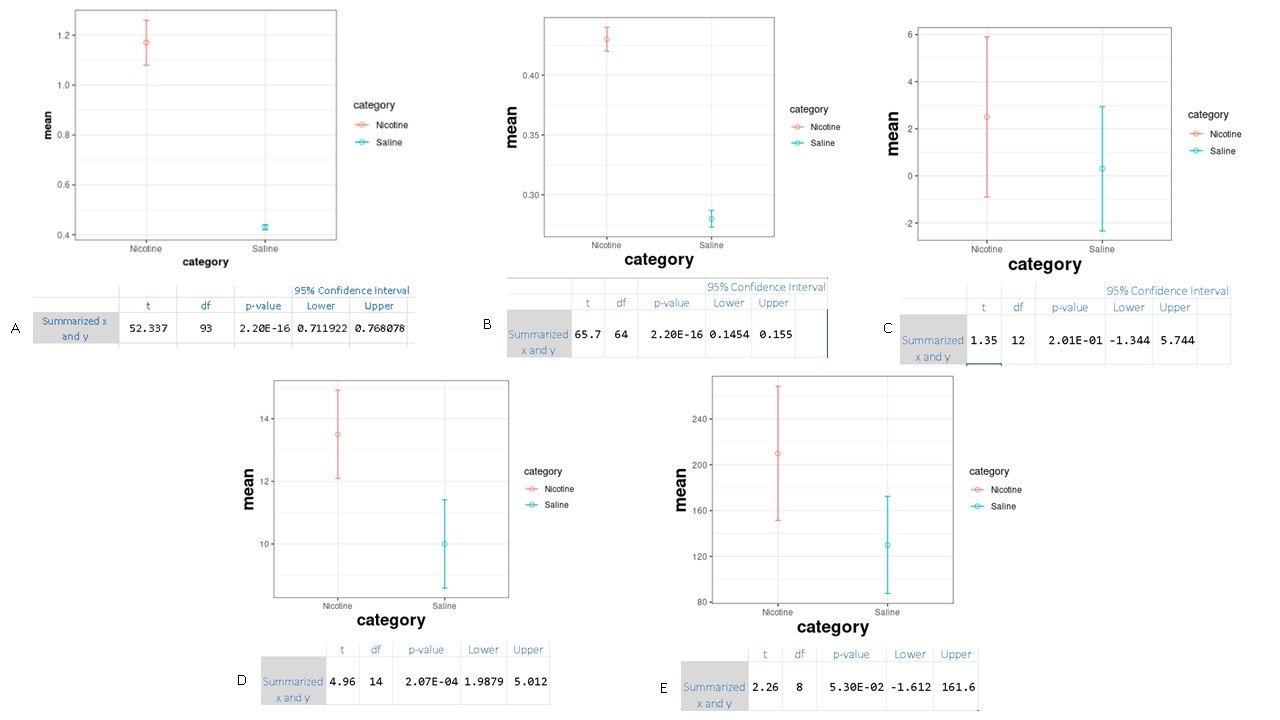Research - Longterm Impact of Prenatal Nicotine Exposure
Background
According to the CDC, tobacco usage among US teens is rising at an alarming rate
1 in 5 (19.6%) high school students and 1 in 20 (4.7%) middle school students have used e-cigarettes in the past 30 days
Nearly 12% have used other forms of tobacco products in the last 30 days
Tobacco usage starts and gets established in adolescence
About 9 out of 10 adults first try smoking by age 18
99% first try by age 26
Per CDC, nicotine abuse in the form of tobacco products during pregnancy increases the likelihood that the child will abuse nicotine in future
Research Questions
What brain functions are responsible for nicotine addiction?
What are the effects to the brain when exposed to nicotine prenatally that leads to nicotine abuse during adolescence?
Ventral Tegmental Area - Brain’s Reward System
Ventral Tegmental area (VTA) is believed to be central to the mechanism of addiction.
VTA is
In the midbrain
An integral part of a networks of structure together known as the reward system
Primarily contains dopaminergic neurons whose axons project into limbic (structures involved with emotions) and cortical (brain structure involved with cognitions)
Dopaminergic neurons produce dopamine, a neurotransmitter involved in addiction
Research the impact of nicotine exposure during pregnancy on VTA of their offspring’s adolescent brain
Methods Used
Searched online databases (PubMed, Cochrane, Proquest, IEEE)
Goal to find research reports in peer reviewed journals describing the impact of prenatal nicotine exposure on VTA
Identified 5 reports out of 1430 based on publication date, language, uniqueness, types of animals used, type of study
Gathered statistical data from the 5 reports
Mean,Standard Deviation, sample size, cohort treatments
Treatments included Nicotine and Saline
Conducted statistical analysis to ensure data accuracy
Standard t-test to eliminate the hypothesis that means of the outcomes are the same
Analysis of variance (ANOVA) on 2 research study data to eliminate the hypothesis that the variances of the data are the same
Refer to the following flow chart on who the analysis was done.
Results
The analysis of the literature data showed the following:
High bursting dopamine neurons in adolescent rats exposed to nicotine prenatally, burst significantly more than they did for saline treated rats (Figure A)
Local Field Potential of dopamine neurons is significantly higher in VTA for rats treated with nicotine prenatally (Figure B)
TH gene does not show a difference in expression in VTA between nicotine treated and saline treated rats (Figure C)
Orexin gene is expressed significantly in VTA for rats that are exposed to nicotine prenatally (Figure D)
NMDA receptors are expressed more in VTA for prenatal nicotine treated rats (Figure E)
Discussion
Prenatal exposure to nicotine significantly impacts the characteristics of the neurons in the brain responsible for addiction as well as the expression of the proteins responsible for the dopamine pathways that cause addiction.
Significant rise in neuron bursting activities
Significant increase in electric potential around the neurons that has been implicated in addiction
Dopamerginic protein receptors are also expressed significantly more
These changes could possibly explain the reasons why exposure to nicotine prenatally leads to nicotine addiction in adolescents
Future Studies
Further studies are needed with both animals and humans to identify the factors involved in addiction as well as finding a cure for nicotine addiction
Animal studies have shown that nicotine causes changes in VTA, one of the key parts of the brain involved in the reward system that causes addiction. The studies have so far considered the individual factors in isolation. Future studies are needed to understand the interactions of multiple factors working in tandem.
Future studies are needed to identify other proteins that are also expressed in the brain’s reward pathway. For example Serotonin, a protein also increases when the brain's reward pathway is triggered.
References
Kalivas (1999), Neurotransmitter regulation of dopamine neurons in the ventral tegmental area, https://doi.org/10.1016/0165-0173(93)90008-N
Dragomir, et al (2016), Ventral Tegmental Area Dopamine Neurons Firing Model Reveals Prenatal Nicotine Induced Alterations Saline
Zhang, et al (2014), Nicotine exposure increases the complexity of dopamine neurons in the parainterfascicular nucleus (PIF) sub-region of VTA
Kazemi, et al (2020), Investigating the influence of perinatal nicotine exposure on genetic profiles of neurons in the sub-regions of the VTA
Morgan et al (2013), Intravenous prenatal nicotine exposure increases orexin expression in the lateral hypothalamus and orexin innervation of the ventral tegmental area in adult male rats.
Roguski et al (2014), Full-gestational exposure to nicotine and ethanol augments nicotine self-administration by altering ventral tegmental dopaminergic function due to NMDA receptors in adolescent rats

